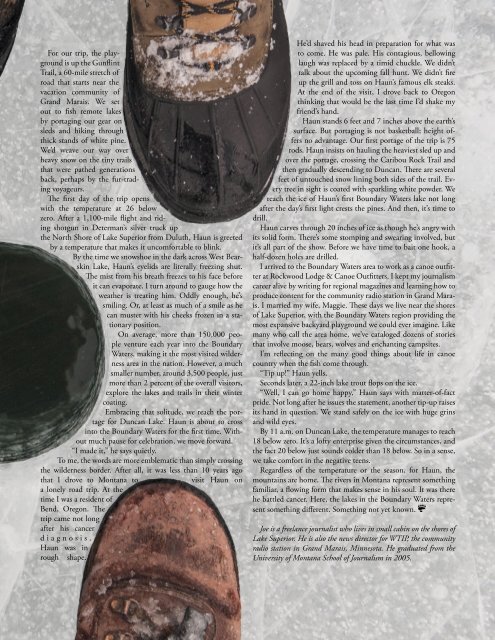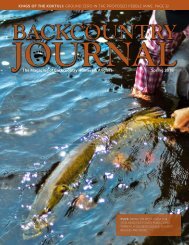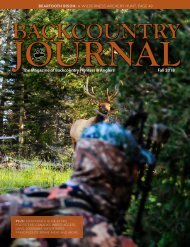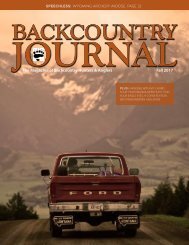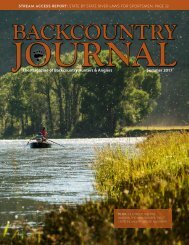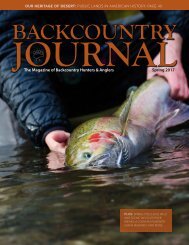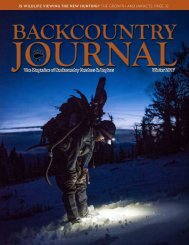BCJ_WINTER18 Digital Edition
You also want an ePaper? Increase the reach of your titles
YUMPU automatically turns print PDFs into web optimized ePapers that Google loves.
For our trip, the playground<br />
is up the Gunflint<br />
Trail, a 60-mile stretch of<br />
road that starts near the<br />
vacation community of<br />
Grand Marais. We set<br />
out to fish remote lakes<br />
by portaging our gear on<br />
sleds and hiking through<br />
thick stands of white pine.<br />
We’d weave our way over<br />
heavy snow on the tiny trails<br />
that were pathed generations<br />
back, perhaps by the fur-trading<br />
voyageurs.<br />
The first day of the trip opens<br />
with the temperature at 26 below<br />
zero. After a 1,100-mile flight and riding<br />
shotgun in Determan’s silver truck up<br />
the North Shore of Lake Superior from Duluth, Haun is greeted<br />
by a temperature that makes it uncomfortable to blink.<br />
By the time we snowshoe in the dark across West Bearskin<br />
Lake, Haun’s eyelids are literally freezing shut.<br />
The mist from his breath freezes to his face before<br />
it can evaporate. I turn around to gauge how the<br />
weather is treating him. Oddly enough, he’s<br />
smiling. Or, at least as much of a smile as he<br />
can muster with his cheeks frozen in a stationary<br />
position.<br />
On average, more than 150,000 people<br />
venture each year into the Boundary<br />
Waters, making it the most visited wilderness<br />
area in the nation. However, a much<br />
smaller number, around 3,500 people, just<br />
more than 2 percent of the overall visitors,<br />
explore the lakes and trails in their winter<br />
coating.<br />
Embracing that solitude, we reach the portage<br />
for Duncan Lake. Haun is about to cross<br />
into the Boundary Waters for the first time. Without<br />
much pause for celebration, we move forward.<br />
“I made it,” he says quietly.<br />
To me, the words are more emblematic than simply crossing<br />
the wilderness border. After all, it was less than 10 years ago<br />
that I drove to Montana to<br />
a lonely road trip. At the<br />
time I was a resident of<br />
Bend, Oregon. The<br />
trip came not long<br />
after his cancer<br />
diagnosis.<br />
Haun was in<br />
rough shape.<br />
visit Haun on<br />
He’d shaved his head in preparation for what was<br />
to come. He was pale. His contagious, bellowing<br />
laugh was replaced by a timid chuckle. We didn’t<br />
talk about the upcoming fall hunt. We didn’t fire<br />
up the grill and toss on Haun’s famous elk steaks.<br />
At the end of the visit, I drove back to Oregon<br />
thinking that would be the last time I’d shake my<br />
friend’s hand.<br />
Haun stands 6 feet and 7 inches above the earth’s<br />
surface. But portaging is not basketball; height offers<br />
no advantage. Our first portage of the trip is 75<br />
rods. Haun insists on hauling the heaviest sled up and<br />
over the portage, crossing the Caribou Rock Trail and<br />
then gradually descending to Duncan. There are several<br />
feet of untouched snow lining both sides of the trail. Every<br />
tree in sight is coated with sparkling white powder. We<br />
reach the ice of Haun’s first Boundary Waters lake not long<br />
after the day’s first light crests the pines. And then, it’s time to<br />
drill.<br />
Haun carves through 20 inches of ice as though he’s angry with<br />
its solid form. There’s some stomping and swearing involved, but<br />
it’s all part of the show. Before we have time to bait one hook, a<br />
half-dozen holes are drilled.<br />
I arrived to the Boundary Waters area to work as a canoe outfitter<br />
at Rockwood Lodge & Canoe Outfitters. I kept my journalism<br />
career alive by writing for regional magazines and learning how to<br />
produce content for the community radio station in Grand Marais.<br />
I married my wife, Maggie. These days we live near the shores<br />
of Lake Superior, with the Boundary Waters region providing the<br />
most expansive backyard playground we could ever imagine. Like<br />
many who call the area home, we’ve cataloged dozens of stories<br />
that involve moose, bears, wolves and enchanting campsites.<br />
I’m reflecting on the many good things about life in canoe<br />
country when the fish come through.<br />
“Tip up!” Haun yells.<br />
Seconds later, a 22-inch lake trout flops on the ice.<br />
“Well, I can go home happy,” Haun says with matter-of-fact<br />
pride. Not long after he issues the statement, another tip-up raises<br />
its hand in question. We stand safely on the ice with huge grins<br />
and wild eyes.<br />
By 11 a.m. on Duncan Lake, the temperature manages to reach<br />
18 below zero. It’s a lofty enterprise given the circumstances, and<br />
the fact 20 below just sounds colder than 18 below. So in a sense,<br />
we take comfort in the negative teens.<br />
Regardless of the temperature or the season, for Haun, the<br />
mountains are home. The rivers in Montana represent something<br />
familiar, a flowing form that makes sense in his soul. It was there<br />
he battled cancer. Here, the lakes in the Boundary Waters represent<br />
something different. Something not yet known.<br />
Joe is a freelance journalist who lives in small cabin on the shores of<br />
Lake Superior. He is also the news director for WTIP, the community<br />
radio station in Grand Marais, Minnesota. He graduated from the<br />
University of Montana School of Journalism in 2005.<br />
WINTER 2018 BACKCOUNTRY JOURNAL | 49


